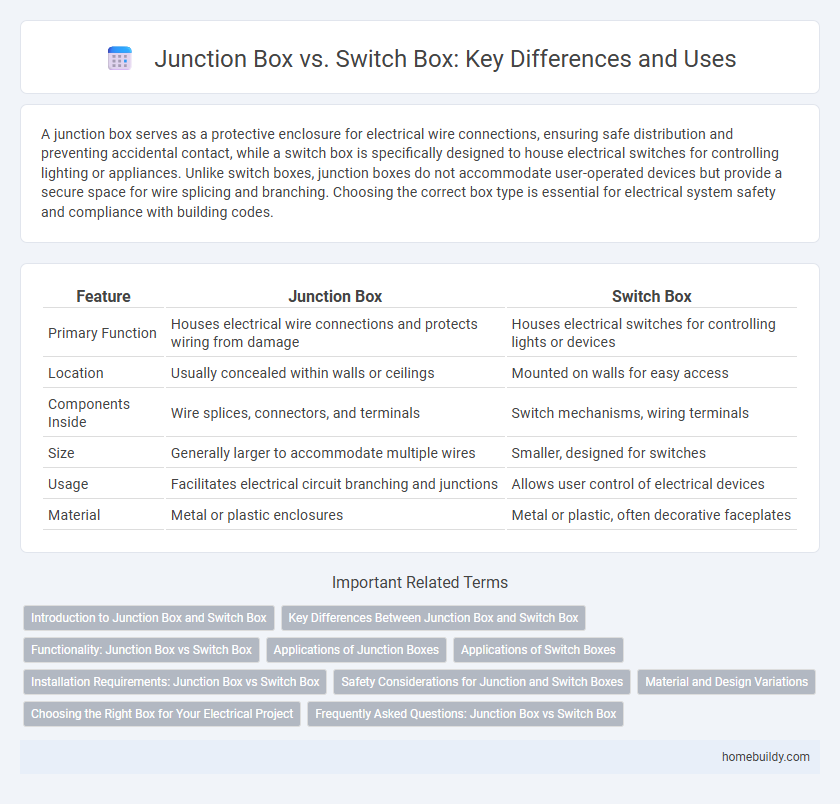A junction box serves as a protective enclosure for electrical wire connections, ensuring safe distribution and preventing accidental contact, while a switch box is specifically designed to house electrical switches for controlling lighting or appliances. Unlike switch boxes, junction boxes do not accommodate user-operated devices but provide a secure space for wire splicing and branching. Choosing the correct box type is essential for electrical system safety and compliance with building codes.
Table of Comparison
| Feature | Junction Box | Switch Box |
|---|---|---|
| Primary Function | Houses electrical wire connections and protects wiring from damage | Houses electrical switches for controlling lights or devices |
| Location | Usually concealed within walls or ceilings | Mounted on walls for easy access |
| Components Inside | Wire splices, connectors, and terminals | Switch mechanisms, wiring terminals |
| Size | Generally larger to accommodate multiple wires | Smaller, designed for switches |
| Usage | Facilitates electrical circuit branching and junctions | Allows user control of electrical devices |
| Material | Metal or plastic enclosures | Metal or plastic, often decorative faceplates |
Introduction to Junction Box and Switch Box
A junction box serves as a protective enclosure for electrical connections, ensuring safety and organization by housing wire splices and terminals. In contrast, a switch box specifically accommodates switches or outlets, providing a secure mounting point for these devices within electrical circuits. Understanding the distinct roles of junction boxes and switch boxes is essential for efficient electrical system design and installation.
Key Differences Between Junction Box and Switch Box
Junction boxes serve as central points for connecting multiple electrical wires and protecting wire splices, while switch boxes primarily house switches or outlets for user control. Junction boxes are typically larger to accommodate numerous cables and facilitate branching circuits, whereas switch boxes are smaller and designed specifically for device mounting. The material and design of junction boxes ensure wire safety and accessibility, whereas switch boxes prioritize ease of operation and installation of switches or receptacles.
Functionality: Junction Box vs Switch Box
A junction box serves as a central hub for connecting multiple electrical wires, providing a secure enclosure to protect splices and prevent electrical hazards. In contrast, a switch box is designed specifically to house electrical switches or dimmers, facilitating user control over lighting and appliances. While junction boxes focus on wire management and safety, switch boxes prioritize accessibility and operation of electrical controls.
Applications of Junction Boxes
Junction boxes serve as secure enclosures for electrical connections, protecting wiring in residential, commercial, and industrial applications, unlike switch boxes that primarily house switches or outlets. They facilitate branching of electrical circuits and provide access points for maintenance, ensuring safety and reliability in complex wiring systems. Widely used in outdoor installations and large-scale electrical projects, junction boxes support diverse configurations and environmental protection requirements.
Applications of Switch Boxes
Switch boxes primarily serve in controlling electrical circuits by housing switches that manage power flow in residential and commercial wiring systems. They are commonly installed in wall cavities to facilitate easy access for turning lights or appliances on and off, making them essential in room lighting and fan control applications. Unlike junction boxes that mainly connect and protect wire splices, switch boxes also provide mounting points for switches and dimmers, enabling user interaction with electrical circuits.
Installation Requirements: Junction Box vs Switch Box
Junction boxes require installation with accessible covers to ensure safe wiring connections and comply with electrical codes, typically mounted flush or surface-mounted within walls or ceilings. Switch boxes must accommodate switches or outlets, ensuring proper depth and secure mounting to support device installation and maintenance. Both boxes demand grounding and adherence to local electrical standards, but switch boxes often have more specific dimensional requirements to fit switch devices.
Safety Considerations for Junction and Switch Boxes
Junction boxes and switch boxes both serve distinct roles in electrical systems, with safety considerations crucial to their proper use. Junction boxes provide a secure enclosure for wire splices, reducing the risk of electrical shorts and fire hazards, while switch boxes safely house switches and outlets to prevent accidental contact with live wires. Ensuring boxes are appropriately rated for their location, such as using weatherproof enclosures outdoors, is essential for maintaining electrical safety and compliance with NEC (National Electrical Code) standards.
Material and Design Variations
Junction boxes are typically made from durable, non-metallic materials like PVC or metal such as steel or aluminum, designed to safely house electrical connections and protect wiring from environmental damage. Switch boxes, on the other hand, often use lighter materials like plastic or thermoplastics and feature specialized designs to accommodate switches and outlets, emphasizing ease of installation and accessibility. The design variations reflect their distinct functions, with junction boxes prioritizing cable management and protection, while switch boxes focus on user interface and mounting stability.
Choosing the Right Box for Your Electrical Project
Selecting the right enclosure between a junction box and a switch box depends on the specific electrical requirements and application. Junction boxes house and protect wire connections, allowing multiple cables to join safely, while switch boxes are designed to accommodate light switches or outlets with precise mounting needs. Understanding the voltage rating, wiring complexity, and installation environment ensures the appropriate choice for durability and compliance with electrical codes.
Frequently Asked Questions: Junction Box vs Switch Box
A junction box is an enclosure used to protect and consolidate electrical wire connections, ensuring safety and ease of maintenance, whereas a switch box specifically houses electrical switches or outlets for controlling circuits. Frequently asked questions about junction box vs switch box often address their size differences, with junction boxes generally larger to accommodate multiple wire connections, while switch boxes are smaller and designed for a single device. Understanding the distinct functions and installation requirements is crucial for proper electrical system design and compliance with safety standards.
Junction box vs Switch box Infographic

 homebuildy.com
homebuildy.com